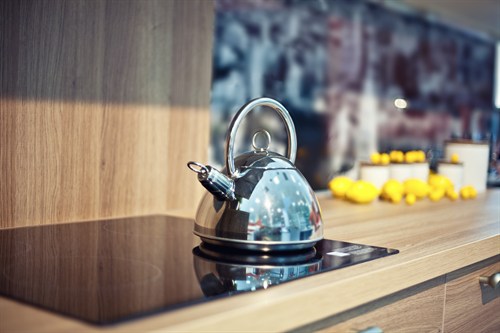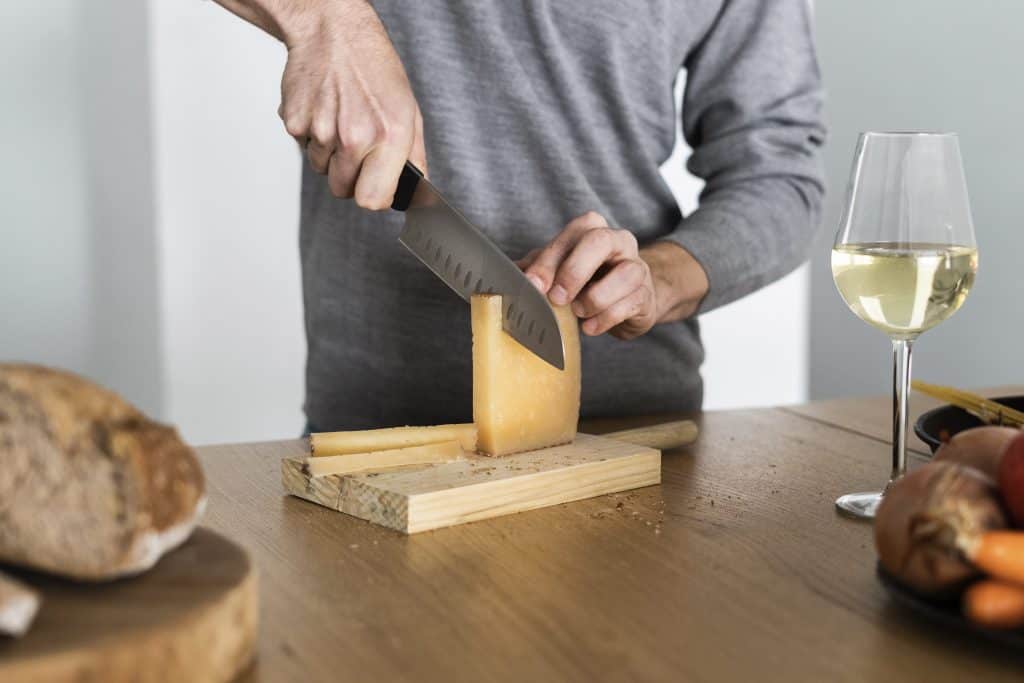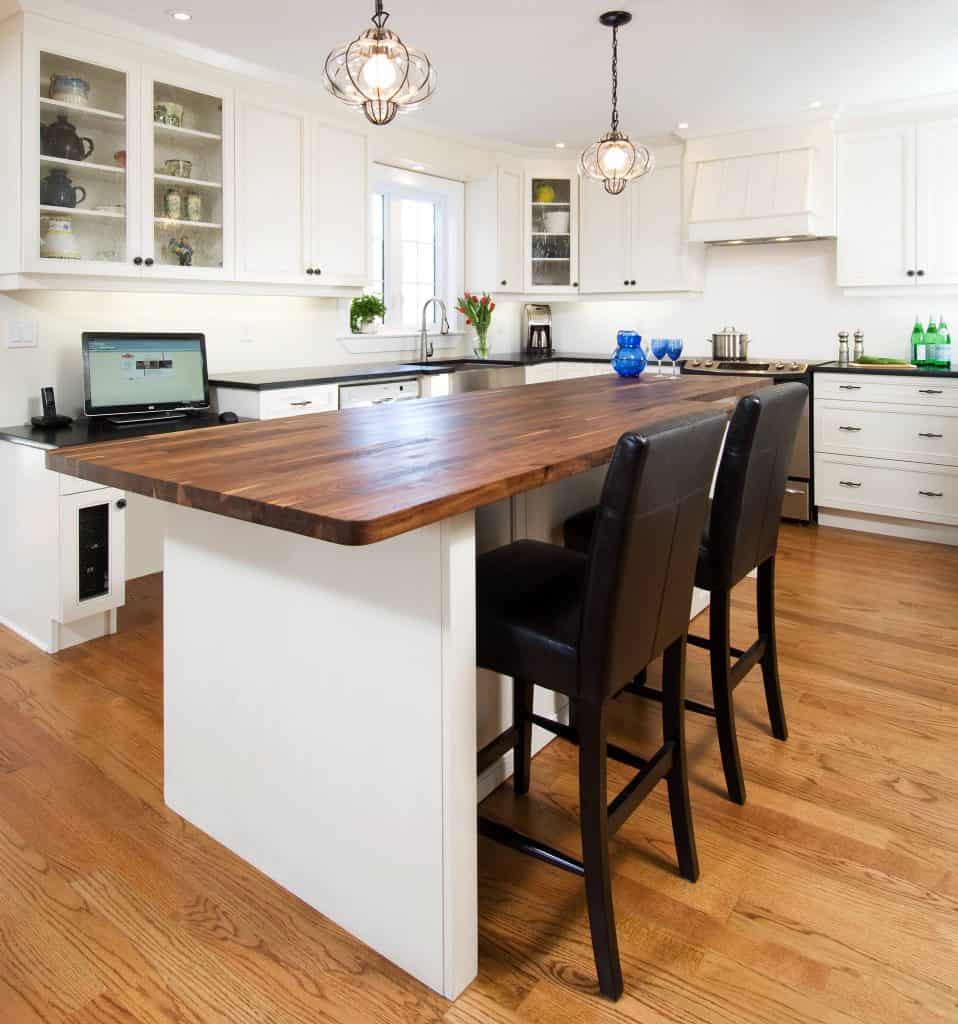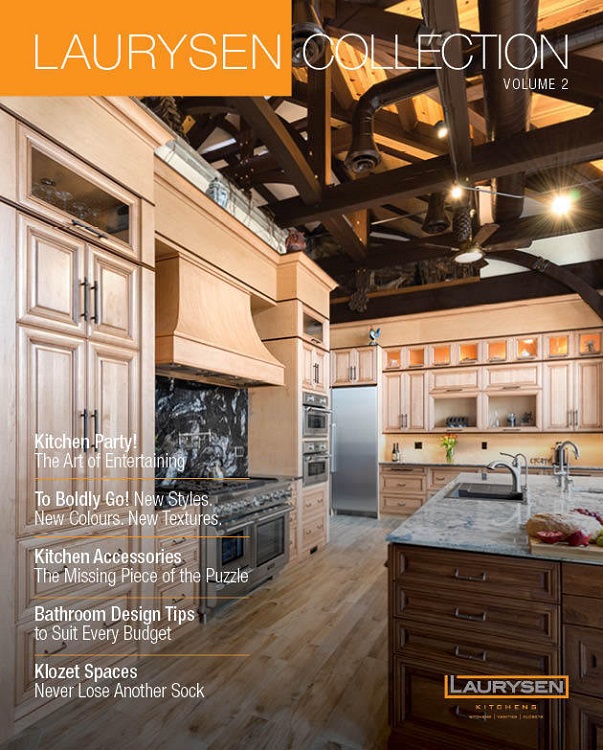
Over the past few years, we’ve continued to see interest in butcher block countertops and other wooden countertops. It seems more and more people want to incorporate wood into their Ottawa kitchen renovations, choosing it over the more popular choices of granite or engineered stones like Corian.
Why? Well, it may have something to do with a resurgence of the natural aesthetic in home design. Wood is able to capture that natural look while still giving off a modern vibe. Also, per square foot, installing wood countertops is one of the more affordable options. Granite, marble and other materials are more expensive.
But it’s more than that. Wood provides a look that no other material can. It’s not the first material that jumps to mind when thinking about kitchen island countertops, but that is a bonus for some. They want their kitchen to stand out, and what stands out more than a beautifully finished wooden countertop?
Wood countertops aren’t for everyone. Like every other material, there are pros and cons of butcher block.
Cons
Let’s get to the bad news first. The truth is, wood requires a lot of care. It can be more easily damaged by spills, and not every kind of wood will stand up to kind of abuse that a normal kitchen counter will see.
However, if they are given the right amount of tender loving care, a wood countertop can retain its clean look long into its life. Generally speaking, most of the negatives to wood can be avoided with good care.
Bacteria Can Live in Poorly Sealed Wood
We’ve all heard it: wood is unsanitary. Well, that’s not exactly true. Properly sealed wood is no more bacteria friendly than tile or granite. In fact, some studies have shown that wood has natural anti-bacterial qualities.
Still, if not given the proper sealant, wood can develop bacteria and mould problems. This may be enough to discourage many wood countertop owners from putting food on it.
Wood is Prone to Damage
Not all wood is created equal. There is some wood that is simply too soft to be used as a countertop. Wood durability is measured by the Janka hardness test, in which the amount of force necessary to ram a steel ball into the wood is measured. At the low end of the Janka scale is a wood like balsa, which can only withstand 100 pounds of force.
The wood used in countertop making generally has a much higher Janka rating. Bolivian cherry, for example, has a Janka rating of 3650 pounds-force.

Still, no wood is going to be as strong as stone, and most wood is prone to knife marks, scratches and even dents. This means that wood counters shouldn’t be used as your primary cutting surface; most of the time, you’ll still want to use a cutting board for food preparation. Harder woods and butcher block counters, which are created by glueing wood boards together for strength and stability, are more durable.
Water damage can also be a problem. If wood is not properly sealed, water that sits on it for too long will begin to seep into it. This is the reason for the ring that coasterless glasses leave on wooden surfaces. Heat is also a threat to wooden kitchen countertops; you always need to place hot pots on a trivet or risk damage to the surface.
BOOK A FREE COUNTERTOP CONSULTATION WITH LAURYSEN TODAY
Wood Needs a Lot of Maintenance
We mentioned this before, but it bears repeating. Wood needs to be treated well. Depending on the type of wood species and the sealant you’re using (usually tung oil or mineral oil), you’ll likely need to reapply it two to three times a year.
And, if you don’t feel like dealing with permanent stains or tired-looking countertops, it’s possible to sand down and refinish butcher block and wood surfaces. It’s a bit of a DIY project, but you can bring your countertops back to life quite easily!
For some, that kind of regimen is worth it. Others may want a counter they can forget about. But, believe us, those who care for their wood countertops will tell you the difference their work makes.
Pros
Now the good stuff! We really like wood. Wood can complement many design styles, and it can be used very creatively because of how easy it is to shape. While it certainly is not for everyone, those who love it do so with a passion.
Wood is Beautiful

Goodness, wood looks good. A properly finished wooden countertop is something that begs to be touched, to be ogled. It’s hard to describe beyond that: it just looks so darn cool.
With so many wood types and colour variations, the possibilities are endless. You can choose light or dark wood and play around with the thickness of your wood countertop—these things can change the look of the entire kitchen.
And, if you are keen on installing butcher block countertops, you have even more options! How the wood is cut, plus the wood grain itself, will drastically impact the look of your countertops. A butcher block countertop can be constructed in different ways.
End Grain: End grain butcher block is commonly used and usually very budget-friendly. Boards are placed on their sides, and the largest surfaces are glued together. The thin edges make up the surface.
Edge Grain: If you’ve ever seen a countertop surface that looks like a grid, that’s an example of edge grain butcher block. Pieces of wood are placed parallel to one another and fused together, forming the checkerboard pattern. It’s labour intensive, thus pricier.
Flat Grain: Flat grain, also known as face grain, plank grain or wide plank, is constructed by glueing wide wood boards together along the edges. While it offers the perfect opportunity to embrace the rustic character and natural beauty of wood’s imperfections, it isn’t as durable a surface.
Wood is Warm
We mean that in two ways: wood is warm to look at, and wood is warm to touch. You’ll be surprised at the difference between a granite countertop and a wood one in terms of heat. A granite countertop will almost always feel cold, while the wood will remain warm.
It’s a small thing, but it makes a big difference. It can make surfaces feel more inviting, enticing people to hang around longer.
And there is nothing that can replace the warmth that wood tones evoke. From the lighter hues of maple and oak to the reddish tones of cherry, there’s something for everyone.
As a sidenote, wood is also quieter than other materials, which adds to the sense of ease it creates.
Wood is Eco-Friendly
Wood countertops can be made out of reclaimed materials, something that we recommend. And when you’re ready to change your countertop or redo your kitchen completely, your wood countertop doesn’t have to end up in a landfill.
Comparisons
Beyond exploring the pros and cons, you may wish to compare wood with other countertop materials, like granite or quartz.
Wood Countertops vs. Granite Countertops
It’ll probably come down to aesthetic preference, but if you’re torn between wood and granite for your countertops, there are a few things to consider. First, they have very different looks: granite has a formal, fancier feel, while wood is rustic and traditional. Both are tough and durable surfaces, but granite is stone, so it can chip and break. Wood, on the other hand, can get dented or scratched. If you want to add pops of colour to your kitchen, granite offers more options than wood. Also, both surfaces require regular sealing to be kept in tip-top shape, but wood is a bit more high maintenance. Lastly, granite is definitely higher-priced than wood.
Wood Countertops vs. Quartz Countertops
If quartz has caught your eye, here are some things to keep in mind. Quartz isn’t 100% natural like wood is. Although a quartz countertop can be made to look like natural stone, with veining and colour variations, it is actually man-made. The process involves mixing quartzite with minerals and binding them together with resin. This produces an incredibly strong, non-porous surface that is virtually maintenance-free. Wood, of course, is not indestructible and needs periodic conditioning and care. If countertop thickness matters to you, know that many quartz countertops max out at 3 inches thick. There are no thickness restraints when it comes to wood; the sky’s the limit! Finally, similar to granite, the price for quartz, compared to wood, is steep.
To Wood or Not to Wood?
Wood is one option among many. If wooden countertops aren’t your preference, check out our guide on other kitchen countertop options to find the right one for you.
Ultimately, it comes down to personal choice. Wood does require work, but some will say that work is worth it for the beauty. Others will fall in love with their wood countertop, turning the chore that was caring for the wood into a pleasure.
But hey, if you like wood, go for it! We will applaud you all the way. If you want to discuss going with a wooden kitchen look, call the countertop experts at Laurysen Kitchens, and we’ll be able to answer your questions.
